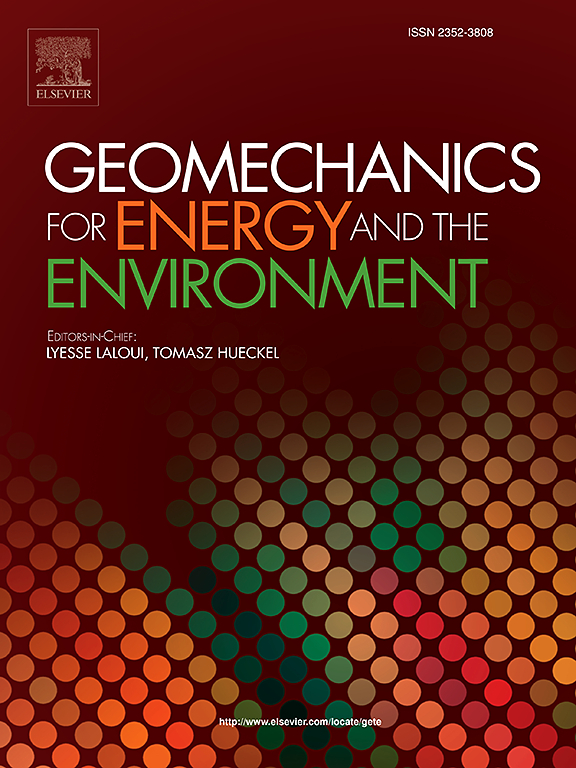Laboratory evidences on accelerated fatigue failure in brittle granitic rock by coupled thermal and mechanical cyclic loading: Acoustic emission monitoring and implication to underground hydrogen storage
IF 3.7
2区 工程技术
Q3 ENERGY & FUELS
引用次数: 0
Abstract
In underground hydrogen storage (UHS), injecting and recovering hydrogen in response to fluctuating energy supply and demand introduces unique challenges associated with thermal and mechanical cyclic loadings, leading to potential fatigue failure of the host rock. However, the effect of thermal cycles on the fatigue of crystalline rocks remains poorly understood. This study presents laboratory evidences on accelerated fatigue failure in brittle granitic rock by coupled thermal and mechanical cyclic loading, using acoustic emission (AE) monitoring. A series of uniaxial compression tests were conducted to characterize fatigue damage evolution under cyclic loading at a constant temperature of ∼8°C (CYC) and cyclic loading with temperature variations of ∼8–80°C (CYC-T). The results show that thermal cycles accelerate fatigue damage, with CYC-T specimens failing after an average of 3.3 cycles compared to 5.8 cycles for CYC specimens. This accelerated fatigue damage was corroborated by their systematically different increasing patterns of cumulative AE counts, which indicates that thermal cycles facilitate coalescence of fatigue microcracks leading to more abrupt and catastrophic failure. The shift in AE peak frequencies reveals the formation of a new group of cracks that differ in size and location, highlighting the complex interactions between thermally induced and mechanically induced microcracks. Young's modulus exhibits only a slight decrease while Poisson’s ratio increases markedly under both loading conditions, indicating significant dilative behavior and crack propagation. The findings in this study underscore the necessity of incorporating thermal stress management strategies in the design and operation of UHS systems for long-term stability and operational sustainability.
热-力耦合循环加载下脆性花岗岩加速疲劳破坏的实验证据:声发射监测及其对地下储氢的启示
在地下储氢(UHS)中,为了应对能源供需波动而注入和回收氢气,会带来与热载荷和机械循环载荷相关的独特挑战,从而导致宿主岩石的潜在疲劳破坏。然而,热循环对结晶岩疲劳的影响仍然知之甚少。利用声发射(AE)监测,研究了热-力耦合循环加载下脆性花岗岩加速疲劳破坏的实验室证据。进行了一系列单轴压缩试验,以表征温度为~ 8°C (CYC)的循环加载和温度变化为~ 8 - 80°C (CYC- t)的循环加载下的疲劳损伤演变。结果表明,热循环加速了疲劳损伤,CYC- t试样平均在3.3次循环后失效,而CYC试样平均在5.8次循环后失效。累积声发射计数的系统不同的增加模式证实了这种加速的疲劳损伤,这表明热循环促进了疲劳微裂纹的合并,导致更多的突变和灾难性破坏。声发射峰值频率的变化揭示了一组新裂纹的形成,这些裂纹的大小和位置不同,突出了热诱导和机械诱导微裂纹之间复杂的相互作用。在两种加载条件下,杨氏模量均略有下降,泊松比显著增加,表明材料具有显著的扩张行为和裂纹扩展。本研究的结果强调了在UHS系统的设计和运行中纳入热应力管理策略的必要性,以实现长期稳定性和运行可持续性。
本文章由计算机程序翻译,如有差异,请以英文原文为准。
求助全文
约1分钟内获得全文
求助全文
来源期刊

Geomechanics for Energy and the Environment
Earth and Planetary Sciences-Geotechnical Engineering and Engineering Geology
CiteScore
5.90
自引率
11.80%
发文量
87
期刊介绍:
The aim of the Journal is to publish research results of the highest quality and of lasting importance on the subject of geomechanics, with the focus on applications to geological energy production and storage, and the interaction of soils and rocks with the natural and engineered environment. Special attention is given to concepts and developments of new energy geotechnologies that comprise intrinsic mechanisms protecting the environment against a potential engineering induced damage, hence warranting sustainable usage of energy resources.
The scope of the journal is broad, including fundamental concepts in geomechanics and mechanics of porous media, the experiments and analysis of novel phenomena and applications. Of special interest are issues resulting from coupling of particular physics, chemistry and biology of external forcings, as well as of pore fluid/gas and minerals to the solid mechanics of the medium skeleton and pore fluid mechanics. The multi-scale and inter-scale interactions between the phenomena and the behavior representations are also of particular interest. Contributions to general theoretical approach to these issues, but of potential reference to geomechanics in its context of energy and the environment are also most welcome.
 求助内容:
求助内容: 应助结果提醒方式:
应助结果提醒方式:


